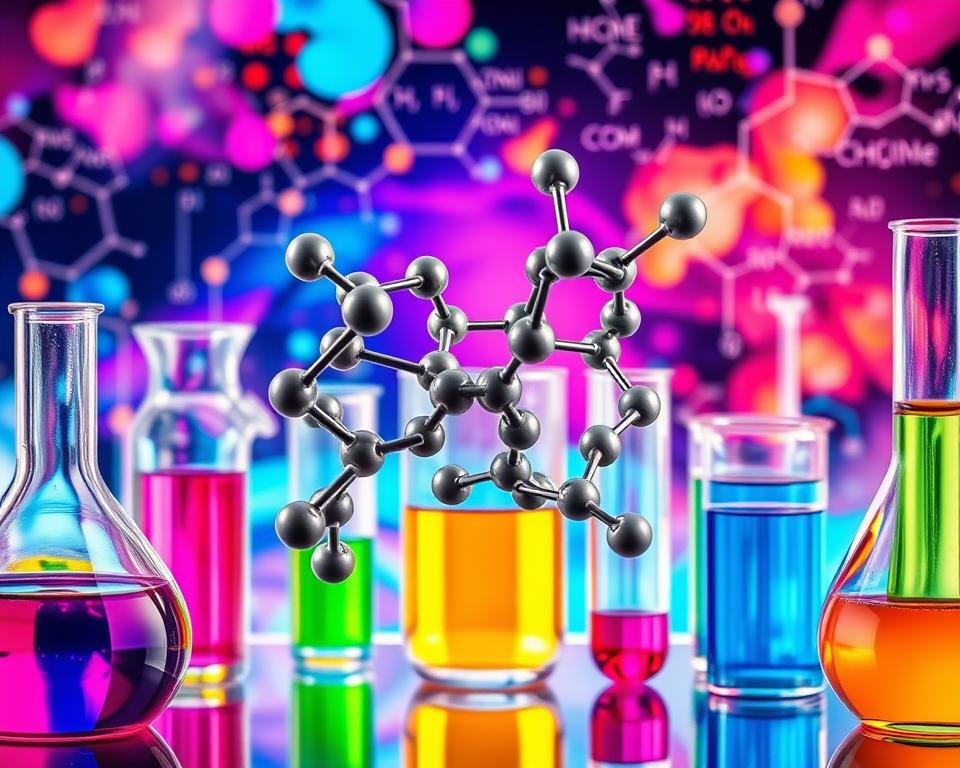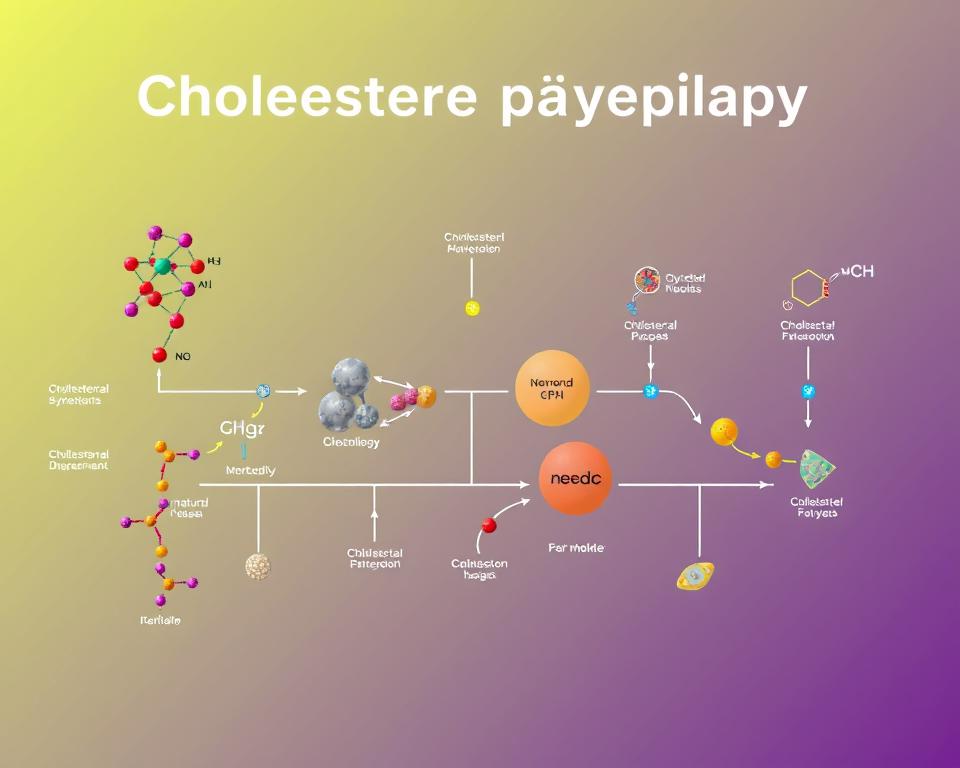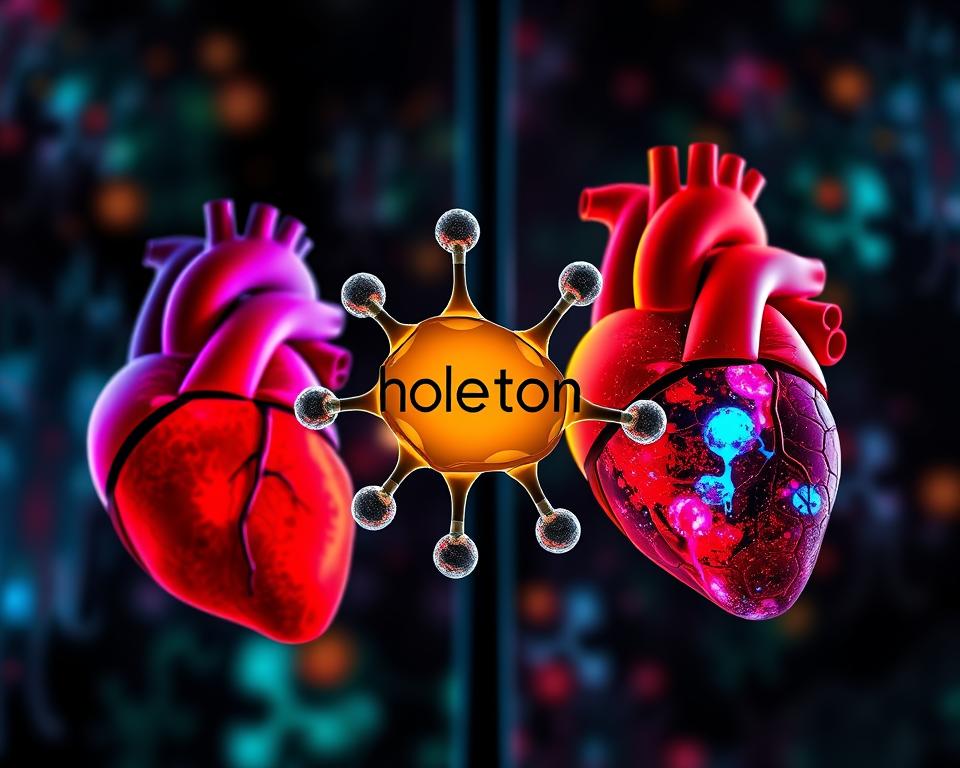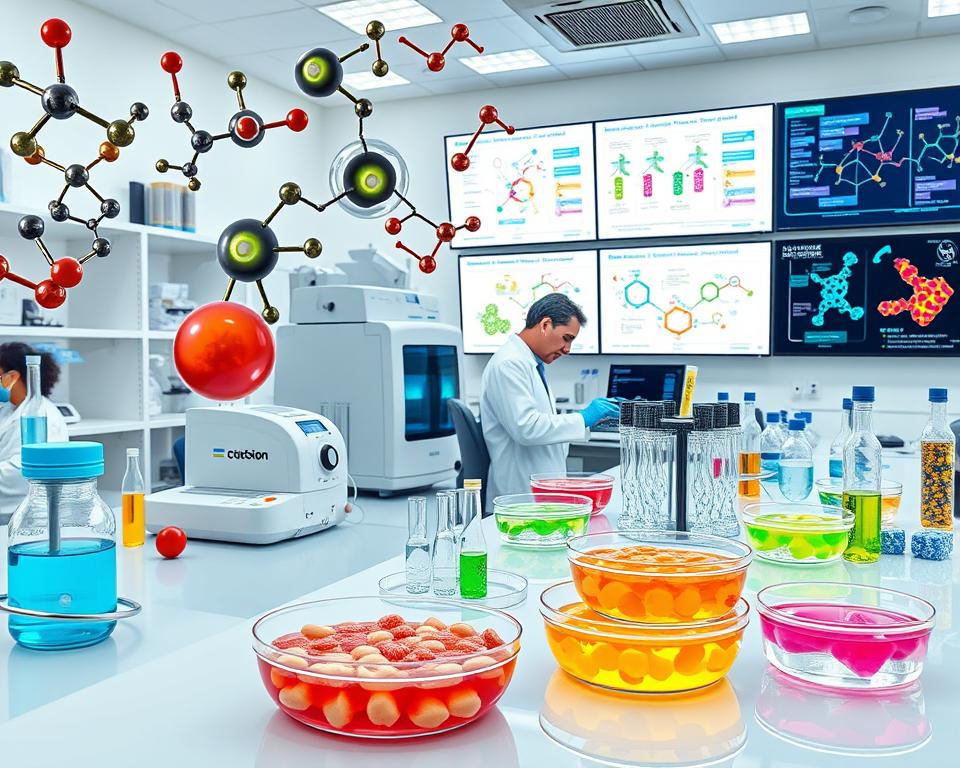Cholesterol’s pivotal role in biological systems extends beyond mere structural components of cell membranes, serving as a precursor for a myriad of steroids and hormones. The elucidation of cholesterol’s chemistry and synthesis is imperative for mitigating health maladies associated with its imbalances, notably cardiovascular diseases. This discourse aims to dissect the complexities of cholesterol biosynthesis, elucidating the underlying mechanisms of its production and its indispensable role in cellular functions. By synthesizing a comprehensive review of the scientific literature and recent breakthroughs in molecular biology, we seek to illuminate the intricate structure of cholesterol and its paramount significance in human health.

Key Takeaways
- The chemistry and synthesis of cholesterol are vital to understanding its biological functions.
- Cholesterol biosynthesis involves complex biochemical pathways.
- Cholesterol serves as a building block for steroid hormones and vitamins.
- Disruptions in cholesterol production can lead to serious health conditions.
- Recent research continues to shed light on cholesterol’s role in lipid metabolism.
Introduction to Cholesterol
Cholesterol, a lipid molecule, plays a pivotal role in biological processes. It is classified as a sterol, vital for cell membrane integrity and fluidity. The significance of cholesterol in health cannot be overstated, given its profound impact.
Within the cholesterol spectrum, low-density lipoprotein (LDL) and high-density lipoprotein (HDL) stand out. LDL, dubbed “bad” cholesterol, tends to accumulate in arteries, potentially leading to cardiovascular disease. Conversely, HDL, or “good” cholesterol, facilitates the transport of cholesterol from arteries to the liver for processing and elimination.
Grasping the balance between LDL and HDL is critical for heart health. While cholesterol is indispensable, excessive LDL levels can significantly jeopardize health. Therefore, acknowledging cholesterol’s dual nature is imperative for informed dietary and lifestyle choices.
Understanding Cholesterol Structure
The chemical structure of cholesterol, denoted by the molecular formula C27H46O, is both intriguing and crucial for grasping its biological significance. It is composed of four interconnected hydrocarbon rings, forming a sterol nucleus. This unique configuration is pivotal to its functionality within biological systems.
Cholesterol exhibits an amphipathic nature, enabling it to interact proficiently with both hydrophobic and hydrophilic environments. This characteristic is essential for its role in cellular membranes, where it ensures fluidity and integrity. The lipid structure of cholesterol, with its long hydrocarbon tail, enhances its hydrophobic properties, allowing it to integrate seamlessly into the lipid bilayer of cell membranes.
An examination of cholesterol’s component parts, such as the sterol nucleus and the hydrocarbon tail, elucidates its biological functions. These attributes enable cholesterol to act as a precursor for various hormones and vitamins, highlighting its critical role in maintaining cellular health and function.
| Component | Description | Function |
|---|---|---|
| Sterol Nucleus | Four fused carbon rings | Provides structural integrity to cell membranes |
| Hydrocarbon Tail | Long non-polar chain | Enhances hydrophobic interactions within membranes |
| Hydroxyl Group | Polar -OH group | Enables cholesterol’s interaction with water |
Chemistry and Synthesis of Cholesterol
The intricate process of cholesterol biosynthesis is paramount for myriad biological functions within the human body. Predominantly occurring in the liver, this complex transformation of acetyl-CoA into cholesterol is facilitated by a series of sophisticated enzymatic reactions. The mevalonate pathway, a cornerstone of the cholesterol synthesis pathway, is instrumental in maintaining equilibrium in our bodily cholesterol levels.
Overview of Cholesterol Biosynthesis
The cholesterol biosynthesis process encompasses several stages, each contributing to the ultimate production of cholesterol. Key enzymes orchestrate the conversion and regulation of substances integral to this metabolic pathway. Dysfunctions in cholesterol biosynthesis can precipitate a plethora of health issues, underscoring its critical role in cellular and systemic well-being.
The Importance of Cholesterol in Biology
Cholesterol’s multifaceted biological roles underscore its indispensable nature for overall health. It plays a pivotal role in maintaining the structural integrity and fluidity of cell membranes, thereby enabling optimal cellular functions. Additionally, cholesterol acts as a precursor for steroid hormones, such as cortisol and sex hormones, influencing diverse physiological processes. The significance of cholesterol in these biological roles accentuates its critical role in lipid metabolism and cellular functions.
The Cholesterol Synthesis Pathway
The intricate process of cholesterol synthesis unfolds through a series of critical metabolic steps, ensuring its efficient production. Delving into these stages offers profound insights into the mechanisms governing cholesterol formation and regulation within the human body.
Key Stages of Cholesterol Formation
The cholesterol biosynthesis pathway commences with the transformation of acetyl-CoA into mevalonate, a pivotal precursor. This initial transformation is followed by the formation of isoprenoid units, indispensable for the subsequent synthesis of squalene. The culmination of this process is the cyclization of squalene into cholesterol, a critical juncture in this complex biochemical pathway.
Differences in Pathway Variations
The diversity in cholesterol production across different species underscores the variability in cholesterol biosynthesis. For example, mammals exhibit a distinct pathway compared to plants and bacteria. These variations are influenced by environmental factors and the availability of dietary cholesterol. Such differences not only illuminate evolutionary biology but also underscore the critical role of cholesterol in diverse biological contexts.

| Organism Type | Cholesterol Synthesis Pathway | Adaptations |
|---|---|---|
| Mammals | Acetyl-CoA → Mevalonate → Isoprenoid Units → Squalene → Cholesterol | Efficient synthesis primarily in liver cells |
| Plants | Acetyl-CoA → Sterol Precursors → Phytosterols | Alternative sterols with different structures |
| Bacteria | Acetyl-CoA → Hopanoids | Utilization of hopanoids instead of cholesterol |
Key Enzymes in Cholesterol Synthesis
The regulation of cholesterol synthesis is a complex process, involving numerous cholesterol synthesis enzymes. At the forefront of this mechanism is the HMG-CoA reductase function, which serves as the rate-limiting step in the cholesterol biosynthesis pathway. This enzyme catalyzes the crucial reaction converting HMG-CoA to mevalonate, a key precursor in cholesterol synthesis. Given its pivotal role, HMG-CoA reductase is a primary target for statin drugs, which are widely used for cholesterol management.
Role of HMG-CoA Reductase
HMG-CoA reductase plays an essential role by catalyzing the conversion that significantly impacts cholesterol levels. The enzyme’s activity is tightly regulated through various feedback regulation mechanisms. When intracellular cholesterol concentrations are adequate, the expression of HMG-CoA reductase decreases, thereby reducing overall cholesterol synthesis. This control helps maintain cellular cholesterol homeostasis.
Password of Enzyme Regulation
Multiple regulatory enzymes govern the cholesterol synthesis pathway, each influencing the pathway’s efficiency. Enzyme control in cholesterol synthesis is affected by hormonal signals and nutritional status. For instance, insulin enhances the activity of these regulatory enzymes, stimulating cholesterol production, while glucagon exerts an inhibitory effect. Both transcriptional and post-translational modifications contribute to this intricate regulation, ensuring a balanced synthesis of cholesterol in response to the body’s needs.
| Type of Regulation | Mechanism | Effect on HMG-CoA Reductase |
|---|---|---|
| Feedback Inhibition | Increased cholesterol leads to decreased expression of the enzyme | Reduction in enzyme activity |
| Hormonal Regulation | Insulin activates; glucagon inhibits | Variable enzyme activity |
| Nutritional Status | High-fat diets may downregulate enzyme | Decreased cholesterol synthesis |
Cholesterol Metabolism in the Body
Cholesterol metabolism is pivotal for maintaining health equilibrium. Initiation occurs with dietary cholesterol absorption in the intestines, subsequently transported via lipoproteins. These entities ensure cholesterol distribution across the body, facilitating its utilization in diverse cellular processes.
The liver emerges as a critical node in cholesterol metabolism, capable of either storing excess cholesterol or converting it into bile acids. This conversion is indispensable for the digestion and absorption of dietary fats, thereby underscoring the interdependence between cholesterol and lipid metabolism. The liver’s proficiency in managing cholesterol levels profoundly affects the cholesterol lifecycle, thereby influencing systemic circulation levels.
Cholesterol acts as a precursor for essential hormones, including steroid hormones such as cortisol and sex hormones. Its conversion into these bioactive substances highlights its critical role in regulating various physiological processes. The complex interplay between cholesterol and lipid metabolism underscores their interconnectedness and significant impact on overall health.
Lipid Metabolism and Cholesterol Synthesis
The intricate relationship between lipid metabolism and cholesterol synthesis is paramount for cellular integrity and overall health. The lipid interaction with cholesterol significantly influences biological processes, including the formation of cellular membranes and signaling pathways. A balanced lipid profile is essential to ensure membrane fluidity and functionality, thereby promoting effective cellular function and cholesterol management.
Interactions Between Lipids and Cholesterol
Cholesterol engages in interactions with various lipids, notably triglycerides and phospholipids, to form lipid rafts and membrane structures. These interactions are crucial for cellular signaling and transport mechanisms. An optimal lipid profile is vital to prevent metabolic disturbances that can lead to diseases. Altered lipid metabolism and subsequent changes in cholesterol can disrupt cellular function and cholesterol homeostasis, exacerbating health complications.
Impact on Cellular Function
The influence of cholesterol levels on cellular function is significant. Cholesterol is vital for maintaining membrane fluidity, which impacts receptor signaling and cellular communication. Abnormal cholesterol levels can drastically alter cellular dynamics, potentially leading to conditions such as atherogenesis or neurodegenerative diseases. The metabolism of lipids and their relationship with cholesterol underscore the necessity of monitoring cholesterol’s impact on cells with diligence.
Regulation of Cholesterol Synthesis
The maintenance of cholesterol homeostasis within the organism is a complex process, reliant on sophisticated feedback mechanisms. These mechanisms regulate both cholesterol synthesis and uptake, ensuring that the body’s cholesterol levels remain in equilibrium. Key to this process are liver X receptors (LXRs) and sterol regulatory element-binding proteins (SREBPs), which collaborate to modulate cholesterol levels. This collaboration ensures that cholesterol synthesis is only activated in response to physiological demands.
Feedback Mechanisms
The feedback mechanisms governing cholesterol synthesis are pivotal in maintaining equilibrium in the body’s cholesterol levels. LXRs are instrumental in the expression of genes responsible for cholesterol efflux and transport. Conversely, SREBPs regulate the expression of genes involved in cholesterol synthesis. This dual regulatory system prevents both cholesterol excess and deficiency, thereby contributing to overall homeostasis.
Hormonal Influence on Synthesis
Hormones exert a significant influence on cholesterol synthesis. Insulin, for instance, promotes lipogenesis, thereby increasing cholesterol production. Conversely, glucagon inhibits synthesis, counteracting insulin’s effect. Adrenal hormones also play a crucial role in regulating cholesterol metabolism, influencing pathways associated with steroid hormone synthesis. The intricate interplay between hormones and cholesterol synthesis underscores the complexities of physiological regulation in lipid metabolism.
| Hormone | Effect on Cholesterol Synthesis |
|---|---|
| Insulin | Promotes synthesis |
| Glucagon | Inhibits synthesis |
| Adrenal hormones | Modulate metabolism |
Cholesterol Production and Health
The significance of cholesterol production in health cannot be overstated. This waxy substance, ubiquitous in the human body, is integral to numerous physiological processes. The maintenance of cholesterol levels within a narrow range is paramount, as it directly correlates with the risk of developing conditions such as atherosclerosis and coronary artery disease.
Research unequivocally establishes a link between cholesterol levels and disease prevalence. Elevated cholesterol levels can precipitate arterial plaque formation, thereby restricting blood flow and escalating cardiovascular risk. The equilibrium between high-density lipoprotein (HDL) and low-density lipoprotein (LDL) cholesterol is critical. Elevated HDL cholesterol levels are associated with a diminished risk of heart disease, whereas elevated LDL cholesterol levels are linked to adverse health consequences.
It is imperative to monitor dietary intake and comprehend the influence of lifestyle choices on cholesterol levels. Engaging in regular physical activity, adhering to a diet rich in healthy fats, and eschewing trans fats are all beneficial. Moreover, individuals with a genetic predisposition to high cholesterol may require intensified monitoring to effectively manage their levels.
- Physical activity helps to raise HDL cholesterol.
- A diet rich in fruits, vegetables, and whole grains supports healthy cholesterol levels.
- Regular health screenings can detect high cholesterol early.
In conclusion, the proactive management of cholesterol production is instrumental in shaping health outcomes. This underscores the critical role of maintaining optimal cholesterol levels to avert associated diseases.
Cholesterol Synthesis and Disease
The intricate relationship between cholesterol synthesis and disease provides profound insights into health management. Elevated LDL cholesterol levels are a significant contributor to the development of cholesterol and heart disease. The mechanisms by which excess cholesterol accumulates in arterial plaques are pivotal in atherosclerosis, a primary driver of cardiovascular disease.
Link Between Cholesterol Levels and Cardiovascular Disease
Studies reveal that high LDL cholesterol levels significantly increase cardiovascular risk factors, heightening the risk of heart attacks and strokes. The formation of plaque occurs when excess cholesterol is deposited in arterial walls, resulting in narrowed arteries and compromised blood flow. Therefore, managing cholesterol levels, primarily through lifestyle modifications and medication, is crucial in averting severe cardiovascular complications.
Metabolic Disorders Related to Cholesterol
Abnormal cholesterol synthesis can precipitate several metabolic disorders related to cholesterol. Familial hypercholesterolemia, characterized by significantly elevated LDL cholesterol levels, is a hereditary condition. Other forms of dyslipidemia disrupt the typical cholesterol balance, contributing to severe cardiovascular health issues. These conditions underscore the imperative for heightened awareness and proactive measures in cholesterol management.

Therapeutic Approaches to Managing Cholesterol
Effective cholesterol management strategies integrate pharmacological interventions with lifestyle modifications. Statins, a cornerstone in high cholesterol treatment, effectively lower LDL levels and reduce cardiovascular risk. These medications inhibit HMG-CoA reductase, a critical enzyme in cholesterol synthesis, thus enhancing cholesterol regulation in the body.
Lifestyle interventions also play a pivotal role in cholesterol management. Adopting a heart-healthy diet rich in fruits, vegetables, whole grains, and healthy fats can significantly impact cholesterol levels. Regular physical activity, aiming for at least 150 minutes of moderate exercise each week, further complements medical treatment. Combining these lifestyle changes with statin therapy provides a holistic approach to managing cholesterol and improving overall cardiovascular health.
| Strategy | Description |
|---|---|
| Statins | Medications that lower LDL cholesterol by blocking its production in the liver. |
| Dietary Changes | Incorporating foods that lower cholesterol; such as oats and fish high in omega-3 fatty acids. |
| Exercise | Engaging in regular physical activity to help raise high-density lipoprotein (HDL) cholesterol levels. |
| Weight Management | Maintaining a healthy weight to improve cholesterol levels and reduce cardiovascular risk. |
Recent Advances in Cholesterol Research
Recent breakthroughs in cholesterol research have been facilitated by innovative methodologies in the study of cholesterol biosynthesis. Advanced techniques are now employed to dissect the enzymatic processes and the regulatory mechanisms of biosynthesis pathways. This advancement underscores the pivotal role of emerging technologies, notably genomics and metabolomics, in uncovering novel therapeutic avenues for cholesterol-related disorders.
Innovations in Cholesterol Biosynthesis Studies
The field of cholesterol biosynthesis is undergoing a transformative evolution, marked by groundbreaking innovations. These developments focus on pioneering methodologies that significantly enhance our comprehension of enzymatic processes. Utilizing high-throughput technologies, researchers are able to elucidate the kinetic behavior of enzymes in both physiological and pathological states. Such detailed insights are indispensable for the development of targeted therapies, specifically designed to intervene at precise junctures within cholesterol synthesis pathways.
- High-throughput screening of enzyme activity to identify new drug targets.
- Integration of genomics to understand genetic variations affecting cholesterol metabolism.
- Metabolomic profiling to explore the impact of dietary changes on cholesterol levels.
Future Directions in Cholesterol Metabolism Research
Future research endeavors in cholesterol metabolism are poised to delve deeper into the intricacies of cholesterol metabolism. The investigation of genetic and molecular mechanisms presents promising avenues for the manipulation of biosynthesis pathways. The exploration of microRNAs and their regulatory functions may unveil novel therapeutic modalities for cholesterol management.
- Exploration of genetic modifications to enhance or inhibit specific cholesterol biosynthesis enzymes.
- Research into the role of microRNAs in regulating lipid profiles and cholesterol levels.
- Development of personalized medicine approaches based on individual metabolic responses.

Conclusion
The synthesis of cholesterol represents a complex biochemical process, fundamental to numerous physiological functions. Its intricate chemistry underscores its critical role in cellular structure and signaling, emphasizing the necessity of comprehension in health contexts. The synthesis summary elucidates cholesterol’s dual function: supporting cellular integrity and modulating metabolic processes.
The significance of cholesterol is profound, serving as a precursor for steroid hormones and bile acids. These substances are crucial for digestion and hormonal regulation. However, the balance of cholesterol levels is paramount, as both deficiencies and excesses can precipitate severe health complications, notably cardiovascular diseases. This underscores the imperative for continuous research into cholesterol metabolism, its regulation, and effective management strategies to enhance overall health.
Ultimately, recognizing cholesterol’s diverse roles opens up promising therapeutic avenues and interventions. As ongoing research uncovers new insights, prioritizing the understanding of cholesterol’s complex interactions within the body will remain essential for advancing health and disease prevention.
FAQ
What is cholesterol and why is it important?
Cholesterol, a lipid molecule, is integral to cellular structure and function. It is vital for maintaining cell membrane integrity and serves as a precursor for steroid hormones. Additionally, it is involved in various biochemical processes. However, excessive levels can contribute to health risks, particularly cardiovascular diseases.
How is cholesterol synthesized in the body?
Cholesterol biosynthesis primarily occurs in the liver through a series of complex enzymatic reactions following the cholesterol synthesis pathway. This process involves converting acetyl-CoA into cholesterol via the mevalonate pathway, a critical pathway for cholesterol production.
What are the main enzymes involved in cholesterol synthesis?
Key enzymes in cholesterol synthesis include HMG-CoA reductase, which catalyzes the conversion of HMG-CoA to mevalonate, marking the rate-limiting step in the cholesterol formation process. Other regulatory enzymes also contribute significantly to the regulation of this pathway.
What are the different types of cholesterol?
There are two primary types of cholesterol—Low-Density Lipoprotein (LDL) and High-Density Lipoprotein (HDL). LDL is often referred to as “bad” cholesterol, as elevated levels can lead to plaque formation in arteries, increasing the risk of cardiovascular disease. Conversely, HDL is considered “good” cholesterol, as it helps transport cholesterol away from the arteries and back to the liver for removal from the body.
How does cholesterol metabolism affect health?
Cholesterol metabolism is pivotal in maintaining overall lipid homeostasis in the body. Imbalances in cholesterol levels can lead to metabolic disorders such as dyslipidemia, which significantly increases the risk of cardiovascular diseases. Understanding cholesterol metabolism is crucial for developing effective management strategies.
What role does diet play in cholesterol levels?
Diet significantly influences cholesterol levels, particularly the intake of saturated fats and trans fats, which can raise LDL levels while dietary components like fiber can help lower cholesterol. Incorporating a balanced diet with healthy fats, lean proteins, and plenty of fruits and vegetables can support healthy cholesterol levels.
How is cholesterol synthesis regulated in the body?
Cholesterol synthesis regulation involves complex feedback mechanisms influenced by hormones such as insulin and glucagon. Liver X receptors (LXRs) and sterol regulatory element-binding proteins (SREBPs) play significant roles in maintaining cholesterol homeostasis and modulating the activity of cholesterol synthesis enzymes.
What advancements have been made in cholesterol research recently?
Recent advancements in cholesterol research focus on innovative methods for studying cholesterol biosynthesis and metabolism. Technologies in genomics and metabolomics are paving the way for new therapeutic approaches aimed at manipulating cholesterol pathways, thereby improving health outcomes related to cholesterol levels.
